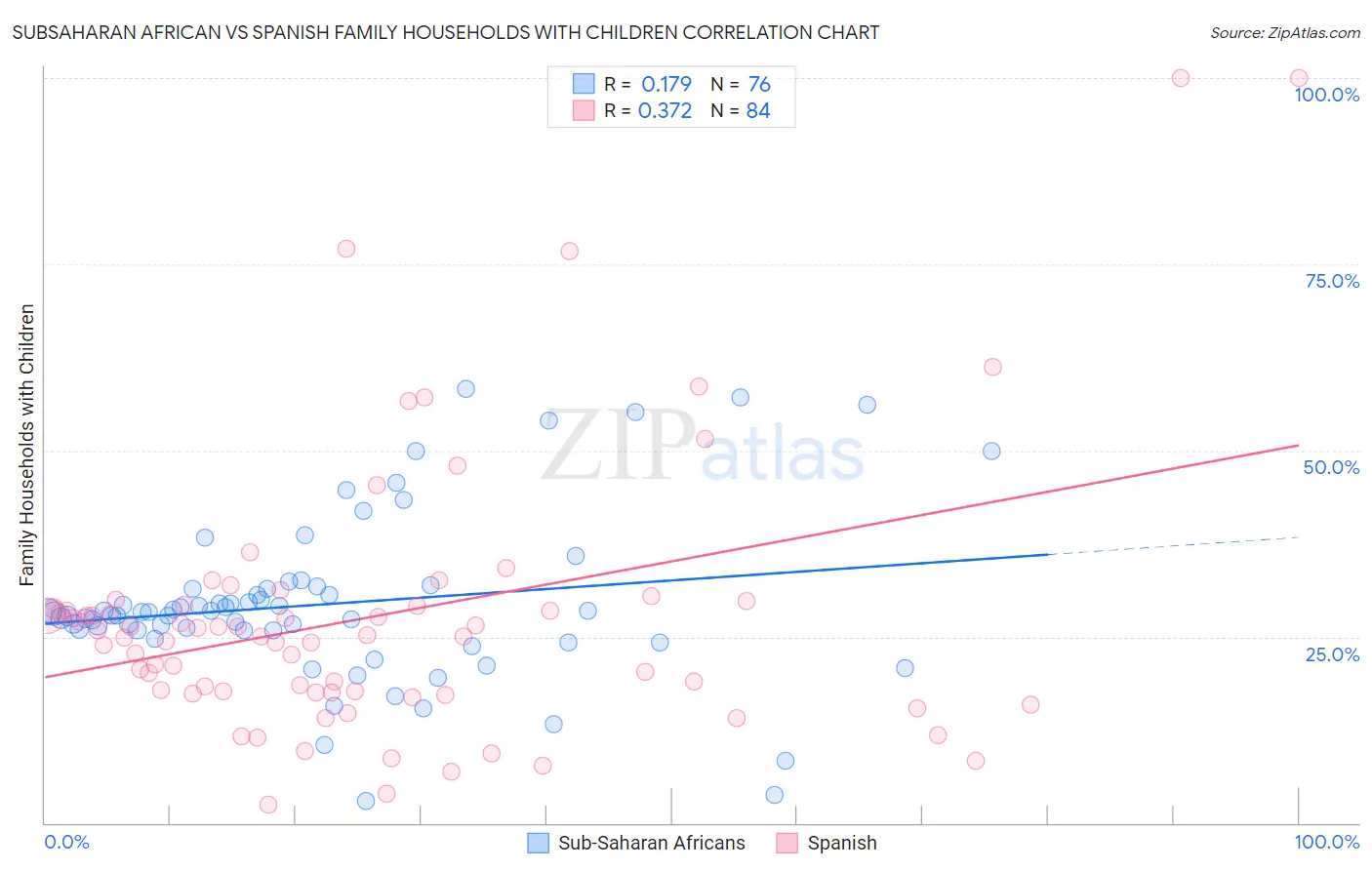Subsaharan African vs Spanish Family Households with Children
COMPARE
Subsaharan African
Spanish
Family Households with Children
Family Households with Children Comparison
Sub-Saharan Africans
Spanish
27.6%
FAMILY HOUSEHOLDS WITH CHILDREN
67.5/ 100
METRIC RATING
160th/ 347
METRIC RANK
27.7%
FAMILY HOUSEHOLDS WITH CHILDREN
81.8/ 100
METRIC RATING
140th/ 347
METRIC RANK
Subsaharan African vs Spanish Family Households with Children Correlation Chart
The statistical analysis conducted on geographies consisting of 507,337,784 people shows a poor positive correlation between the proportion of Sub-Saharan Africans and percentage of family households with children in the United States with a correlation coefficient (R) of 0.179 and weighted average of 27.6%. Similarly, the statistical analysis conducted on geographies consisting of 421,743,519 people shows a mild positive correlation between the proportion of Spanish and percentage of family households with children in the United States with a correlation coefficient (R) of 0.372 and weighted average of 27.7%, a difference of 0.42%.

Family Households with Children Correlation Summary
| Measurement | Subsaharan African | Spanish |
| Minimum | 3.0% | 2.5% |
| Maximum | 58.3% | 100.0% |
| Range | 55.4% | 97.5% |
| Mean | 29.4% | 27.7% |
| Median | 28.2% | 25.1% |
| Interquartile 25% (IQ1) | 25.8% | 17.6% |
| Interquartile 75% (IQ3) | 31.4% | 29.2% |
| Interquartile Range (IQR) | 5.6% | 11.6% |
| Standard Deviation (Sample) | 11.1% | 18.1% |
| Standard Deviation (Population) | 11.0% | 18.0% |
Demographics Similar to Sub-Saharan Africans and Spanish by Family Households with Children
In terms of family households with children, the demographic groups most similar to Sub-Saharan Africans are Romanian (27.6%, a difference of 0.080%), Mongolian (27.6%, a difference of 0.080%), Indian (Asian) (27.6%, a difference of 0.11%), Hungarian (27.6%, a difference of 0.19%), and Comanche (27.6%, a difference of 0.20%). Similarly, the demographic groups most similar to Spanish are Immigrants from Eastern Asia (27.7%, a difference of 0.0%), Swiss (27.7%, a difference of 0.020%), Immigrants from Eastern Africa (27.7%, a difference of 0.060%), Brazilian (27.7%, a difference of 0.080%), and Immigrants from Chile (27.7%, a difference of 0.080%).
| Demographics | Rating | Rank | Family Households with Children |
| Spanish | 81.8 /100 | #140 | Excellent 27.7% |
| Immigrants | Eastern Asia | 81.7 /100 | #141 | Excellent 27.7% |
| Swiss | 81.4 /100 | #142 | Excellent 27.7% |
| Immigrants | Eastern Africa | 80.2 /100 | #143 | Excellent 27.7% |
| Brazilians | 79.6 /100 | #144 | Good 27.7% |
| Immigrants | Chile | 79.5 /100 | #145 | Good 27.7% |
| Basques | 79.5 /100 | #146 | Good 27.7% |
| Immigrants | Moldova | 79.1 /100 | #147 | Good 27.6% |
| Osage | 79.0 /100 | #148 | Good 27.6% |
| Menominee | 78.9 /100 | #149 | Good 27.6% |
| Argentineans | 78.5 /100 | #150 | Good 27.6% |
| Portuguese | 77.8 /100 | #151 | Good 27.6% |
| Ethiopians | 77.0 /100 | #152 | Good 27.6% |
| Immigrants | Cabo Verde | 75.6 /100 | #153 | Good 27.6% |
| Icelanders | 75.3 /100 | #154 | Good 27.6% |
| Comanche | 74.8 /100 | #155 | Good 27.6% |
| Hungarians | 74.6 /100 | #156 | Good 27.6% |
| Indians (Asian) | 71.6 /100 | #157 | Good 27.6% |
| Romanians | 70.8 /100 | #158 | Good 27.6% |
| Mongolians | 70.7 /100 | #159 | Good 27.6% |
| Sub-Saharan Africans | 67.5 /100 | #160 | Good 27.6% |